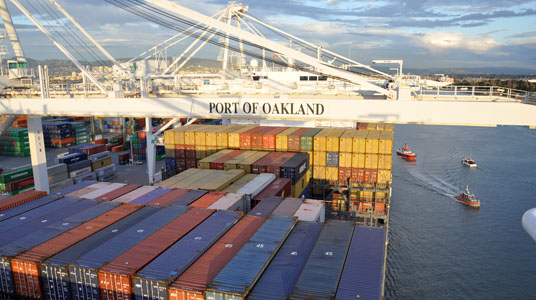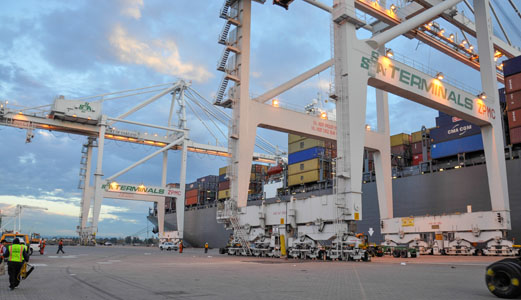Fourteen diesel-emission reduction grants totaling $2 million have been awarded to agencies in the United States Environmental Protection Agency’s (EPA) Regions 9 and 10, which includes California, to help reduce pollution caused by diesel engines.

As of last November, the large cranes used at the Port of Oakland to offload containers from vessels run on electricity from the port’s recently completed shore-to-ship power grid. Photo courtesy of Port of Oakland
By Bill Picture
Published: February, 2014
Fourteen diesel-emission reduction grants totaling $2 million have been awarded to agencies in the United States Environmental Protection Agency’s (EPA) Regions 9 and 10, which includes California, to help reduce pollution caused by diesel engines.
The Port of Oakland received $415,932 of that money to help cover the cost of outfitting two of its conventional, diesel-powered rubber-tire gantry cranes—the smaller cranes used to organize containers at the port after they’ve been unloaded from vessels—with an energy storage system similar to today’s hybrid passenger vehicles. All of the large cranes used to load and unload cargo from vessels at the Port of Oakland are already powered entirely by electricity.
Each rubber gantry crane’s existing diesel engine will be replaced with a smaller diesel generator, a rechargeable battery and an energy management system. The new generator will only be used to charge the batteries, drastically reducing the amount of diesel emissions.
The grant to the Port of Oakland, along with the 13 other grants, is being administered by the West Coast Collaborative, a partnership between federal, state and local agencies, the private sector, researchers and environmental groups in EPA’s Regions 9 and 10. The group’s goal is to develop, advance and promote strategies to reduce diesel emissions. The West Coast Collaborative’s private sector partners include representatives of the agriculture, construction and cargo-shipping industry.
According to a West Coast Collaborative report, making this switch to hybrid electric power will reduce diesel fuel consumption and greenhouse gas emissions by 60 percent, with a 90 percent reduction in even nastier nitrogen oxide and particulate matter emissions. Older diesel engines spew into the air a toxic mixture containing a few dozen pollutants deemed “hazardous” by the EPA. In fact, the risk of developing cancer from exposure to diesel emissions is said to be seven times greater than the combined risk posed by all of the other 181 air toxins currently tracked by the EPA. Diesel emissions have also been linked to asthma and bronchitis.
Emissions from rubber tire gantry cranes can vary greatly depending on the age of a crane’s engine, as well as usage. Still, communities like West Oakland, which is plagued by higher-than-average diesel pollution as a result of activity at the port, are expected to experience a significant improvement in air quality once the diesel-powered cranes are converted to hybrid electric power.
In a written statement, EPA Pacific Northwest Office Administrator Dennis McLerran said that the benefits these communities would experience as a result of the projects being undertaken with the grant money would be “immediate.”
Beyond the threat to public health posed by diesel pollution is the role it plays in climate change. Black carbon in the particulate matter emitted from diesel engines absorbs light and acts as a warming agent. Black carbon’s effect on the environment is believed to be 2,000 times greater than standard carbon emissions; and 57 percent of black carbon emissions in the United States come from diesel engines.
Port of Oakland ahead of the curve
This move marks another significant stride made by the port toward achieving its self-set clean-air goal. In 2008, the port committed to reducing diesel emissions by 85 percent by 2020, and then developed the Maritime Air Quality Improvement Plan to meet that goal.
“And based on our 2012 seaport emissions inventory, we have already reduced our diesel particulate matter from seaport sources by 70 percent,” says Port of Oakland representative Roberto Bernardo. “We are only 15 percent away from reaching our 2020 goal.”
The emission reductions come as the result of several clean-air measures undertaken at the port. First, all trucks now serving the port have engines manufactured after 2006, when emissions standards were seriously tightened.
Then, last November, the port celebrated the completion of a shore-to-ship power grid that provides electricity to docked vessels. Until then, vessels burned diesel to maintain power while docked. Now, vessels can shut down their engines and plug into the port’s power infrastructure. Eleven tons of diesel emissions will be eliminated from the air as a result of the Port of Oakland’s $70 million Shore Power Program.
It was state air-quality regulators that prompted the creation of the power grid. Several years ago, they set a January 2014 deadline for 50 percent of vessels calling at California ports to plug into onshore power sources. The number of vessels required to power down and plug in jumps to 80 percent in 2020.
Oakland was the first port to complete its grid, thanks to help from the Bay Area Air Quality Management District, the California Air Resources Board and the Metropolitan Transportation Commission.
“And we also want to acknowledge our ocean carrier partners who have invested in using cleaner diesel fuel for their ships over the past several years,” said Bernardo. “Beginning this year, vessel operators are using an even cleaner fuel than before as they enter California waters.”
The 14 projects funded by this latest round of grants are expected to eliminate more than 262 tons of nitrogen oxides, 16 tons of particulate matter and 8,317 tons of carbon dioxide in EPA Regions 9 and 10 over the life of the projects.
Jared Blumenfeld, administrator for the EPA’s Pacific Southwest Office, applauded the Port of Oakland, its fellow awardees and all the members of the West Coast Collaborative for the work being done to reduce diesel emissions. Blumenthal said he hopes that they’ll serve as a model for the rest of the country and the world: “By promoting clean diesel technologies, we can save lives locally and play a leadership role on climate change globally.”

The Port of Oakland’s grant was one of 14 diesel-emission reduction grants recently awarded by the U.S. Environmental Protection Agency. Photo courtesy of Port of Oakland

In 2008, the Port of Oakland committed to reducing diesel emissions by 85 percent by 2020. As of last month, the port had already reduced emissions from seaport sources by 70 percent. Photo courtesy of Port of Oakland




